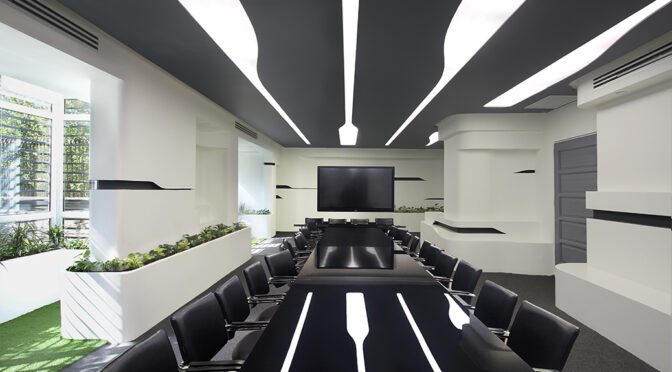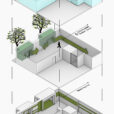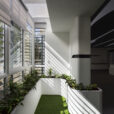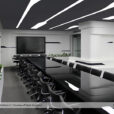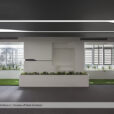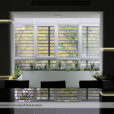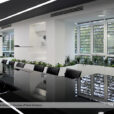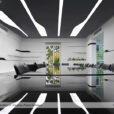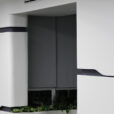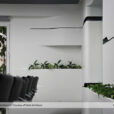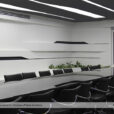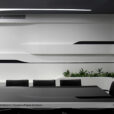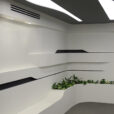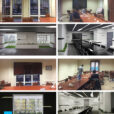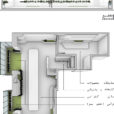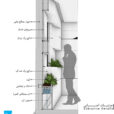بازسازی سالن کنفرانس شرکت بدرتک الکتریک
دفتر معماری هشت (شهاب احمدی، ایمان هدایتی)
موقعیت: تهران، ایران
تاریخ: ۱۳۹۷
مساحت: ۱۰۰ مترمربع
وضعیت: ساختهشده
کارفرما: شرکت بدرتک الکتریک
تیم پروژه: نیلوفر محمدزاده، مائده مساح، الهه صادقی، مرضیه کریمی، علی احمدی، شقایق بیرامی
عکس: مهران پوروزیری، سعید فتوحی
طرح یک پرسش همیشگی: ما زندگی میکنیم تا کار کنیم، یا کار میکنیم تا زندگی کنیم؟
امروزه، با کاهش منابع و افزایش جمعیت، و به تبع آن، افزایش نیاز به کسب درآمد برای تامین هزینهها، افراد بیشترین زمان مفید روز خود را در محل کار میگذرانند. بدینترتیب، عملا تفکیک سنتی دوگانه زیستـکار ممکن نیست و محیط کار بخش مهمی از فضای زندگی فرد را تشکیل میدهد. پروژه بازسازی سالن کنفرانس شرکت بدرتک الکتریک (نمایندگی دستگاههای تهویهمطبوع) پاسخی است به چرخه درهمتنیده زیستـکار، که سعی کرده است تجربه مطلوبتری از «حضور» در فضا را برای ساکنان خود فراهم کند.
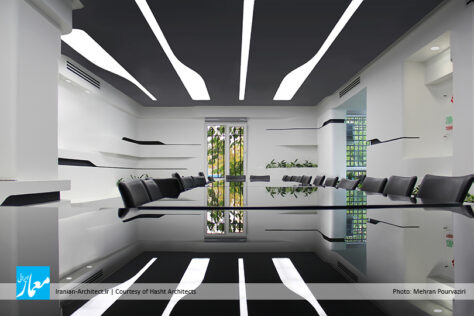
خواسته کارفرما این بود که طراحی فضا بهگونهای باشد که پاسخگوی عملکردهای متفاوتی چون برگزاری همایشها، کلاسهای آموزشی و مهمانیهای دورهای کاری باشد. اما طرح با دو چالش اصلی مواجه بود: اول اینکه کوچکبودن ابعاد فضا با عملکردهای مورد انتظار در تناقض بود؛ ثانیا ستونی در وسط وجود داشت که نحوه برخورد با آن میتوانست تاثیر فراوانی بر حس فضا بگذارد. بر این اساس، تصمیم کلی ما برای ساماندهی پروژه، در دو بخش قابل تعریف بود: اول اینکه با افزایش کیفیت متغیرهای محیطی همچون نور و فضای سبز، بتوانیم تاثیر بهسزایی در بهبود کیفیت فضای اداری، و به دنبال آن، افزایش بهرهوری کارکنان داشته باشیم؛ از طرف دیگر، با بازتعریف حوزههای عملکردی مختلف، و کشش و ادغام آنها در یکدیگر، بتوانیم فضایی چندعملکردی و پویا، متناسب با رویدادهای گوناگون داشته باشیم.
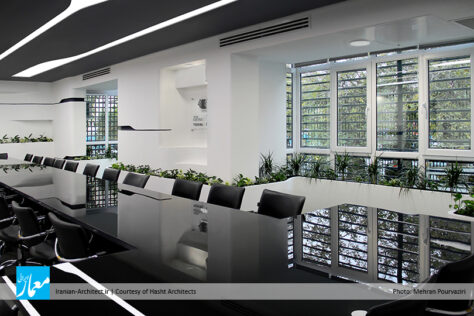
فرایند طراحی را با تعیین حوزههای عملکردی آغاز کردیم. فضای میانی که قسمت عمده فضا را تشکیل میداد، به محل برگزاری جلسه اختصاص یافت، و فضایی را که قبلا آبدارخانه بود، به فضای کتابخانه تبدیل کردیم، و کمدهای متعددی که در نقاط مختلف وجود داشتند، در این قسمت ساماندهی شدند. با این کار، جدارهها از قید و بند کمدهای قدیمی آزاد و به فضایی قابل انعطاف برای نمایش تابلوهای تبلیغاتی و لوحهای تقدیر در نقاط مختلف تبدیل شدند. در قدم بعدی، فضای نورگیر را که در مجاورت این فضا قرار داشت و با یک درب صلب از فضای سالن کنفرانس جدا میشد، با حذف تیغه مابین، به داخل فضای اصلی کشیدیم و این فضا به صورت ادامهای از فضای سالن، به عنوان نمایشگاه محصولات تعریف شد.
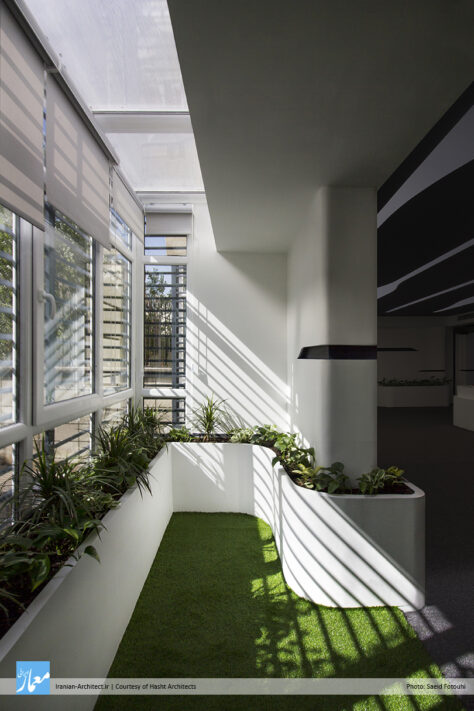
در مرحله بعد، توجه ما به دو تراس جلب شد که در مجاورت فضای سالن وجود داشتند و با جدارهای از فضای اصلی جدا شده بودند. در این مرحله تصمیم گرفتیم با حذف این تیغهها، به دو دستاورد مهم برسیم: اول اینکه با این کار، حجم فضای تراسها به سالن اضافه شد و به این وسیله، اثر کوچکبودن فضای سالن کاهش یافت؛ دیگر آنکه با تقویت و کشش سبزینگی موجود در تراسها به داخل فضای سالن، پیوندی ناگسستنی بین این دو فضا به وجود آمد، گویی با برداشتن این تیغه، انرژی طبیعت که پیش از این، در پشت حصاری محبوس شده بود، آزاد و درون فضا دمیده شد، و اینگونه، نور، سبزینگی و طراوت را برای فضای اداری به ارمغان میآورد. ادبیات طراحی فرم نیز بر اساس همین انرژی سیال حاصل از دمش طبیعت به داخل شکل گرفت تا بتواند فضاهای مختلف را به درون هم بکشاند و به هم متصل کند. از لغزش این انرژی روی جدارهها نیز فضاهای مختلفی برای حضور و رشد گیاهان، و همچنین برای پاسخگویی به نیازهای عملکردی همچون محل قرارگیری تندیسها و لوح افتخارات، و موارد تبلیغاتی که مورد نیاز کارفرما بود، به وجود آمد.
در مرحله اجرا، خواست کارفرما این بود که پروژه با حداقل هزینه و کیفیت مطلوب اجرا شود. بنابراین متریال گچبرگ در دو حالت مختلف، یکی برای اجرای سطوح در معرض آسیب و در مجاورت گیاهان، و یکی برای سطوح معمولی انتخاب شد. همچنین تمام گیاهان داخل پروژه به سیستم زهکشی متصل شدند. برای سیستم تهویهمطبوع نیز از داکت اسپلیت بر فراز تراسها و نقاط دیگر در اطراف سقف استفاده شد.
Badr Tech Electric Company’s Conference Hall Renovation
Hasht Architects (Shahab Ahmadi, Iman Hedayati)
Location: Tehran, Iran
Date: 2018
Area: 100 sqm
Status: Completed
Client: Badr Tech Electric Co.
Project Team: Niloofar Mohammadzadeh, Maede Massah, Elahe Sadeghi, Marzieh Karimi, Ali Ahmadi, Shaghayegh Beyrami
Photo: Mehran Pourvaziri, Saeid Fotouhi
A frequent question rises: we live to work, or we work to live. Which one is true?
As population increased, leading to decrease in living resources, humans had to spend a tremendous amount of their valuable time, at work places, to afford living expenses. In fact, it is almost impossible to create an effective balance between work and personal life, as every individual has to spend a considerable amount of time in work, rather than being at home. In this regard, the project tends to provide a more pleasant environment for its inhabitants, in terms of having integrated personal and work life, which can meet personnel’s needs.
Due to the client request, the space design had to be suitable for various functions such as holding conferences, training classes, and periodic work parties. This project had two main challenges. The first challenge was the space limitations that had conflict with the expected functions. The second challenge which our perspective of encountering it, would have had a great effect of the sense of the space, was a column in the middle of the hall. Our general idea for managing this project was divided to two concepts. For significant impact on improving the quality of office space, to ultimately increase employees productivity, the first concept was increasing the quality of environmental variables like sunlight and green areas. On the other hand, our second concept was redefining different functional areas, and the merging of them together, in order to create a multi-functional space that is suitable for a variety of events.
The start of the design process was by identifying the functional areas. The mid-space which formed a major amount of the space, was allocated to the meetings center. The former kitchen space turned out to become the library space, and numerous closets that existed in different parts of the hall, were organized in this section. With this change, the walls were free from old closets, and revolved into a flexible space for displaying billboards and plaques of appreciation. In the next step, the skylight space that was adjacent to the project space, and was separated from the conference hall space by a rigid door, was united with the main space, by removing the middle wall. This added space was then known as the exhibition of products.
In the next step, two terraces that were adjacent to the hall space, and were separated from the project space by a wall, drew our attention. The decision of this stage was to remove these walls for obtaining two important achievements. The first achievement was that the terrace space was united with the project space; so that, we can compensate for the limited space in the beginning. The other achievement was the transfer of the green nature from the terraces to the hall space. It seemed like until now, the energy of nature was prisoned by the walls, and now, this energy is free and spreading through the entire work space.
The client’s desire for implementing this project, was to finish the project with the least expenses and required quality. So, the gypsum material was chosen for two different surfaces: one for surfaces that were exposed to damage and also adjacent to plants, and another for normal surfaces. All the plants in this project were connected to a drainage system. Duct splits were used in the terraces ceilings and the roofs, for air conditioning.

